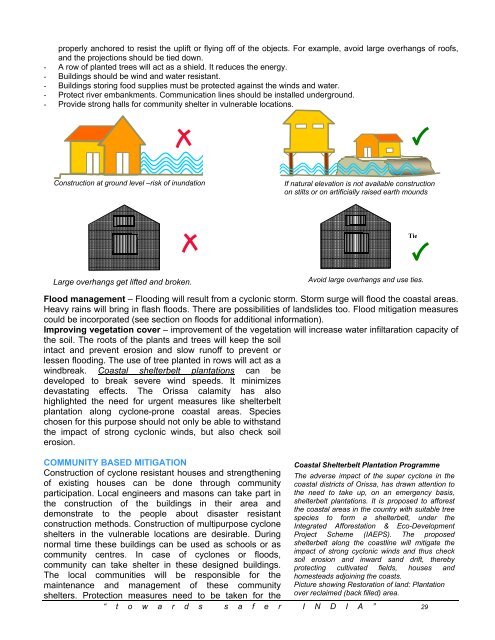Hazards, Disasters And Your Community - United Nations ...
Hazards, Disasters And Your Community - United Nations ...
Hazards, Disasters And Your Community - United Nations ...
You also want an ePaper? Increase the reach of your titles
YUMPU automatically turns print PDFs into web optimized ePapers that Google loves.
properly anchored to resist the uplift or flying off of the objects. For example, avoid large overhangs of roofs,<br />
and the projections should be tied down.<br />
- A row of planted trees will act as a shield. It reduces the energy.<br />
- Buildings should be wind and water resistant.<br />
- Buildings storing food supplies must be protected against the winds and water.<br />
- Protect river embankments. Communication lines should be installed underground.<br />
- Provide strong halls for community shelter in vulnerable locations.<br />
Construction at ground level –risk of inundation<br />
If natural elevation is not available construction<br />
on stilts or on artificially raised earth mounds<br />
Tie<br />
Large overhangs get lifted and broken.<br />
Avoid large overhangs and use ties.<br />
Flood management – Flooding will result from a cyclonic storm. Storm surge will flood the coastal areas.<br />
Heavy rains will bring in flash floods. There are possibilities of landslides too. Flood mitigation measures<br />
could be incorporated (see section on floods for additional information).<br />
Improving vegetation cover – improvement of the vegetation will increase water infiltaration capacity of<br />
the soil. The roots of the plants and trees will keep the soil<br />
intact and prevent erosion and slow runoff to prevent or<br />
lessen flooding. The use of tree planted in rows will act as a<br />
windbreak. Coastal shelterbelt plantations can be<br />
developed to break severe wind speeds. It minimizes<br />
devastating effects. The Orissa calamity has also<br />
highlighted the need for urgent measures like shelterbelt<br />
plantation along cyclone-prone coastal areas. Species<br />
chosen for this purpose should not only be able to withstand<br />
the impact of strong cyclonic winds, but also check soil<br />
erosion.<br />
COMMUNITY BASED MITIGATION<br />
Coastal Shelterbelt Plantation Programme<br />
Construction of cyclone resistant houses and strengthening The adverse impact of the super cyclone in the<br />
of existing houses can be done through community coastal districts of Orissa, has drawn attention to<br />
participation. Local engineers and masons can take part in the need to take up, on an emergency basis,<br />
the construction of the buildings in their area and shelterbelt plantations. It is proposed to afforest<br />
the coastal areas in the country with suitable tree<br />
demonstrate to the people about disaster resistant species to form a shelterbelt, under the<br />
construction methods. Construction of multipurpose cyclone Integrated Afforestation & Eco-Development<br />
shelters in the vulnerable locations are desirable. During Project Scheme (IAEPS). The proposed<br />
normal time these buildings can be used as schools or as shelterbelt along the coastline will mitigate the<br />
impact of strong cyclonic winds and thus check<br />
community centres. In case of cyclones or floods,<br />
soil erosion and inward sand drift, thereby<br />
community can take shelter in these designed buildings. protecting cultivated fields, houses and<br />
The local communities will be responsible for the homesteads adjoining the coasts.<br />
maintenance and management of these community Picture showing Restoration of land: Plantation<br />
shelters. Protection measures need to be taken for the over reclaimed (back filled) area.<br />
“ t o w a r d s s a f e r I N D I A ” 29

















